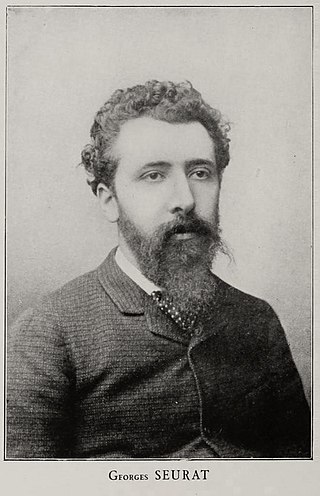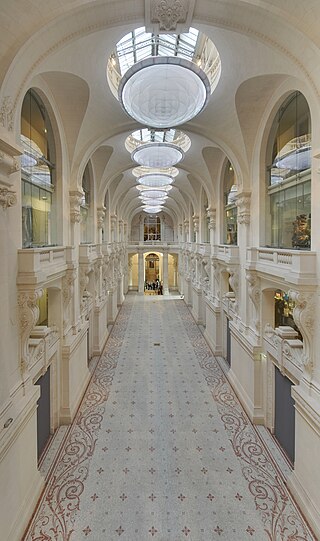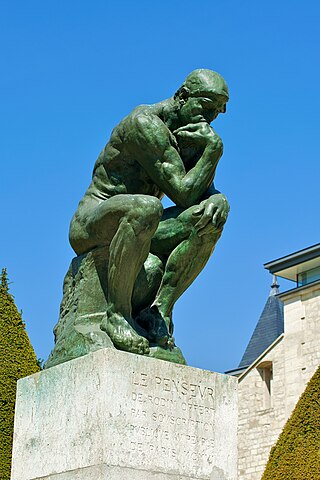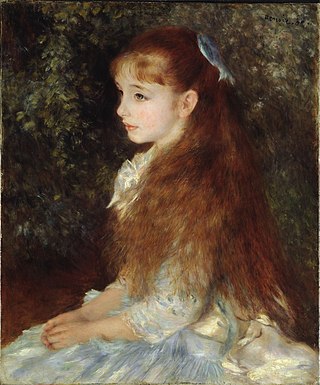
Pierre-Auguste Renoir was a French artist who was a leading painter in the development of the Impressionist style. As a celebrator of beauty and especially feminine sensuality, it has been said that "Renoir is the final representative of a tradition which runs directly from Rubens to Watteau."

Georges Pierre Seurat was a French post-Impressionist artist. He devised the painting techniques known as chromoluminarism and pointillism and used conté crayon for drawings on paper with a rough surface.

Charles-François Daubigny was a French painter, one of the members of the Barbizon school, and is considered an important precursor of impressionism.

Jean Dominique Antony Metzinger was a major 20th-century French painter, theorist, writer, critic and poet, who along with Albert Gleizes wrote the first theoretical work on Cubism. His earliest works, from 1900 to 1904, were influenced by the neo-Impressionism of Georges Seurat and Henri-Edmond Cross. Between 1904 and 1907, Metzinger worked in the Divisionist and Fauvist styles with a strong Cézannian component, leading to some of the first proto-Cubist works.

The Camondo family was a prominent Jewish family of financiers and philanthropists who were active in Europe and the Ottoman Empire.

Count Abraham Salomon Camondo was a Jewish Ottoman-Italian financier and philanthropist, and the patriarch of the Camondo family.

Félix Henri Bracquemond was a French painter, etcher, and printmaker. He played a key role in the revival of printmaking, encouraging artists such as Édouard Manet, Edgar Degas and Camille Pissarro to use this technique.

Louise Béatrice Reinach was a French socialite and a Holocaust victim.

Count Moïse de Camondo was an Ottoman Empire-born French banker and art collector. He was a member of the prominent Camondo family.

Nazmi Ziya Güran was a Turkish Impressionist painter and art teacher.

Les Arts décoratifs is a private, non-profit organization which manages museums of decorative arts located in Paris, France.

The Musée Nissim de Camondo is a historic house museum of French decorative arts located in the Hôtel Moïse de Camondo at 63, rue de Monceau, on the edge of Parc Monceau in the 8th arrondissement of Paris, France. The nearest Paris Métro stops are Villiers and Monceau on Line 2.

Marie Bracquemond was a French Impressionist artist. She was one of four notable women in the Impressionist movement, along with Mary Cassatt (1844-1926), Berthe Morisot (1841-1895), and Eva Gonzalès (1847-1883). Bracquemond studied drawing as a child and began showing her work at the Paris Salon when she was still an adolescent. She never underwent formal art training, but she received limited instruction from Jean-Auguste-Dominique Ingres (1780–1867) and advice from Paul Gauguin (1848–1903) which contributed to her stylistic approach.

Proto-Cubism is an intermediary transition phase in the history of art chronologically extending from 1906 to 1910. Evidence suggests that the production of proto-Cubist paintings resulted from a wide-ranging series of experiments, circumstances, influences and conditions, rather than from one isolated static event, trajectory, artist or discourse. With its roots stemming from at least the late 19th century, this period is characterized by a move towards the radical geometrization of form and a reduction or limitation of the color palette. It is essentially the first experimental and exploratory phase of an art movement that would become altogether more extreme, known from the spring of 1911 as Cubism.

For centuries, Paris has attracted artists from around the world, arriving in the city to educate themselves and to seek inspiration from its artistic resources and galleries. As a result, Paris has received a reputation as the "City of Art". Home to some of the world's most famous museums and galleries, including the Louvre and the Musée d'Orsay, the city today remains home to a thriving community of artists. Paris is recognized globally for its public landmarks and masterpieces of architecture including the Arc de Triomphe and a symbol of France, the Eiffel Tower.
Gustave Achille Gaston Migeon was a French historian of the arts of the world.

Henri Michel-Lévy, was a French impressionist painter.

Head, also known as Tête d'homme, or Portrait d'homme, is an early Cubist sculpture created in 1913 by the Hungarian avant-garde sculptor Joseph Csaky. This black and white photograph from the Csaky family archives (AC.111) shows a frontal view of the original 1913 plaster. Head was exhibited at Galerie Clovis Sagot, 46, rue Laffitte, Paris, 1913–14, and at the 1914 Salon des Indépendants titled Tête d'homme. It was subsequently exhibited at Galerie Moos, Geneva, 1920, titled Buste.

The Portrait of Irène Cahen d’Anvers, or The Little Girl with the Blue Ribbon or Little Irène, is an oil painting by French Impressionist artist Pierre-Auguste Renoir.
The Société des amis du Louvre is a voluntary association created in 1897 whose objective is to buy objects with an artistic, archeological, or historical value for the Louvre museum.


















